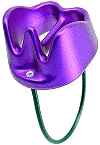For convenience, I've divided the belay devices
in my collection into a number of categories. Although there are
more rigorous methods to classify belay devices, I've chosen an
informal approach that I think will be easier for most people
to follow than some purely academic method.
| ID |
This is
just my catalog number so that I can keep these straight |
| Weight |
Weights are in grams.
Webbing, slings, etc. are not included unless they were supplied
with the device. There is an exception: I put a 3 mm. keeper sling
on many of my belay devices, and its weight is included. |
| Height,
Width, Thickness |
I've given the dimensions
in millimeters. The measurements are in perpendicular directions.
I've chosen to measure the maximum dimensions instead of the
most obvious dimensions. Sometimes this leads to numbers that
are more than what you would expect - for example, the thickness
of a bent plate would be more than the thickness of the unbent
plate. |
| Standard
Volume |
The standard volume
is just the product of the height, width, and thickness divided
by 1000. This gives a volume in milliliters of a box that the
device will fit into. Odd shaped devices are penalized by this
formula, but since they are generally harder to pack, this number
might be useful. |


 Belay Devices
Belay Devices